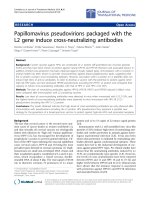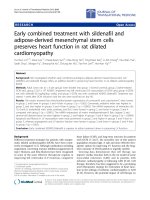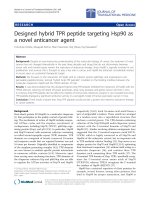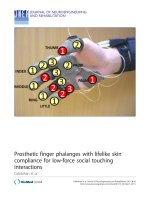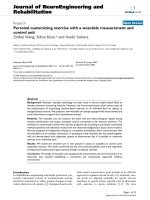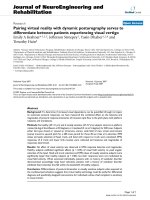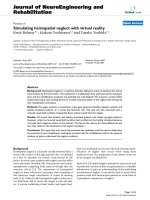Báo cáo hóa học: " Micro-nano hybrid structures with manipulated wettability using a two-step silicon etching on a large area" ppt
Bạn đang xem bản rút gọn của tài liệu. Xem và tải ngay bản đầy đủ của tài liệu tại đây (3.19 MB, 10 trang )
NANO EXPRESS Open Access
Micro-nano hybrid structures with manipulated
wettability using a two-step silicon etching on
a large area
Beom Seok Kim, Sangwoo Shin, Seung Jae Shin, Kyung Min Kim and Hyung Hee Cho
*
Abstract
Nanoscale surface manipulation technique to control the surface roughness and the wettability is a challenging
field for performance enhancement in boiling heat transfer. In this study, micro-nano hybrid structures (MNHS)
with hierarchical geometries that lead to maximizing of surface area, roughness, and wettability are developed for
the boiling applications. MNHS structures consist of micropillars or microcavities along with nanowires having the
length to diameter ratio of about 100:1. MNHS is fabricated by a two-step silicon etching process, which are dry
etching for micropattern and electroless silicon wet etching for nanowire synthesis. The fabrication process is
readily capable of producing MNHS covering a wafer-scale area. By controlling the removal of polymeric
passivation layers deposited during silicon dry etching (Bosch process), we can control the geometries for the
hierarchical structure with or without the thin hydrophobic barriers that affect surface wettability. MNHS without
sidewalls exhibit superhydrophilic behavior with a contact angle under 10°, whereas those with sidewalls preserved
by the passivation layer display more hydrophobic characteristics with a contact angle near 60°.
Introduction
In general, boiling heat transfer is considered to be very
effective mechanism for cooling the high heat-generat-
ing devices due to the large latent heat by phase transi-
tion accompanied by fast transport of gas-phased
bubbles. In many industrial fields related to energy con-
version, e.g., nuclear power plants, heat pump, and elec-
tronics, improving the performance of boiling heat
transfer based on surface treatment and modification is
a key issue [1-3]. Both microstructures and nanostruc-
tures are often used to enhance the performance of boil-
ing heat transfer by controlling and modifying s tructure
geometries.
There have been numerous studies on boiling heat
transfer improvements obtained by microscale structure
fabrication using artificial structures, such as patterned
circular/rectangular holes/pillars, and conical/cyli ndrical
cavities [4,5]. With the development of feasible nanos-
cale fabrication technique including nanostructure pat-
terning by conventional photolithography [6] or
maskless method [7] that can easily manipulate the sur-
face wettability [8,9], nanoscale surface treatments could
also be applied to boiling heat transfer enhancement.
3D macro-porous metallic surface layer with nanoscale
porous structures-enhanced heat transfer coefficient,
especially at low heat flux of 1 W · cm
-2
,over17times
compared to the plain surface [ 10]. Top-down etched
silicon nanowires (SiNWs) and electrodeposited copper
nanowires improved the boiling performance by u p to
100% compared to a plain silicon surface, by increasing
surface wettability where the nanowires exhibited super-
hydrophilic behavior [11]. With tilted copper nanorods,
synthesized by an electron-beam evaporator, pool boil-
ing heat transfer characteristics were also enhanced by
the increased wettability and the nucleation sites result-
ing from the intrinsic nature of the dense nanowires
[12]. Additionally, some studies report the increase in
boiling behavior using carbon nanotub e-coated surfaces
[13]. It may be inferred from these references that
nanoscale structures greatly increase the surface area
and wettability and lead to the enhancement of boiling
behavior by supplying adequate liq uid to the boi ling
surface and extending the burn-out limit of the surfaces.
* Correspondence:
Department of Mechanical Engineering, Yonsei University, 262, Seongsanno,
Seodaemun-gu, Seoul 120-749, Korea
Kim et al. Nanoscale Research Letters 2011, 6:333
/>© 2011 Kim et al; licensee Springer. This is an Open Access article distributed under the terms of the Creative Commons Attribution
License ( 2.0), which permits unrestricted use, distribution, and reproduction in any medium,
provided the original work is properly cited.
In light of previous efforts to enhance boiling perfor-
mance by increasing the nucleation sites and the surface
wettability, micro-nano hybrid structures (MNHS)
[14,15] may offer extraordinary boiling heat transfer per-
formance. Specifically, hierarchical MNHS can signifi-
cantly increase the boiling surface area, the surface
roughness and the surface wettability, compared to sin-
gle-scale structures. However, there has been relatively
little research on the fabrication and the application of
hierarchical MNHS to enhance the performance of boil-
ing heat transfer further.
For the fabrication of MNHS, nanowire-adorned
microstructures by selective electrochemical growth of
nanowires [14], using a porous anodic alumina template
[16] and the dual-scale hierarchical structures with SU-8
photoresist (PR) using capillary force lithography [17]
were reported. However, for boiling applications there
are some specialized requirements which should be met
in prior. First, the boiling surface must have good ther-
mal properties, including high thermal conductivity and
durability under high heat flux conditions. Second, the
surface area and r oughness should be increased further
by modifying surface geometries, for example, combining
microscale patterns with nanoscale structures, to expel
the heat from the surface sufficiently and to act as a bub-
ble nucleation site. Third, the fabrication technique must
be simple, and must enable one to simultaneously
synthesize nanoscale structures and microstructures over
a large area. Fourth, a hydrophilic surface, which can
readily attract and supply the cooling agent to the boiling
surface, is desirable to prevent a film formation on heated
surface for boiling applications. In view of these require-
ments, previous MNHS fabrication techniques, which
were complicated by the use of templates and additional
electrode layers, or were intended for low thermal con-
ductivity and hydrophobicity based on polymer materials,
may be inappropriate for boiling applications.
In this study, we focus on the hierarchical structure
formations by fabricating hierarchical MNHS that meet
the boiling heat transfer requirements mentioned above.
Inparticular,weproposeasimple fabrication process
using two-step silicon etching: silicon deep trench reac-
tive ion etching (DRIE) for microstructure fabrication
and electroless silicon etching for nanowire formation.
These processes are feasible and rob ust. In particular, the
electroless silicon etching process enables uniform nano-
wires to be readily fabricated over a large area at room
temperature, without any catalysts or templates [18-20].
By this simple technique, we fabricated wafer-scale hier-
archical MNHS made up of micropillars/cavities covered
with uniformly grown nanowires. By controlling the
removal of natively coated polymeric passivation layers
during DRIE (or Bosch process) [21], we obtained various
combined structures by two-step silicon etching process.
Especially, by removing the polymeric passivation layers
which induce the conglomeration of nanowires at the
boundary of micropatterns and thus make hydrophobic
surfacebyprohibitingthecoolingagentfromspreading
or wicking, hierarchical MNHS can readily serve to
pump the water cooling agent to the surface due to the
superhydrophilic characteristics. We validated that the
surface wettability of those surfaces with hierarchical
MNHS by measuring the surface contact angle for de io-
nized water. Based on our results, we believe that the sur-
faces with hierarchical MNHS may be candidates for
boiling heat transfer applications.
Experimental section
Sample preparation: top-down SiNWs
Using electroless metal deposition and anisotropic silicon
etching, SiNWs with very high aspec t ratios can readily
be synthesized on a wafer-scale area of a silicon substrate.
We refer to previous studies for detailed electrolyte
recipes and fabrication processes [11,19,20]. Prior to the
formation of micropatterns and nanowires, the silicon
wafer was thoroughly cleaned. Here, we u sed an n-type
silicon wafer (phosphorous-doped) with a (100) orienta-
tion, a resistivity between 1 and 10 Ω cm, and a thickness
of 500 μm. To begin with, a 4-inch silicon wafer was
cleaned for 40 min in an H
2
O
2
and H
2
SO
4
solution with
a volume ratio of 1:3, to remove organic materials. This
was followed by an additional cleaning process with acet-
one and methanol for 5 min each in turn, using a sonica-
tor. For fabricating SiNWs by electroless etching, the
wafer was immersed in an aqueous solution of 0.02 M
AgNO
3
and 5 M HF for 70 min at room temperature.
When diluted AgNO
3
and HF solution are used for elec-
troless silicon etching, Ag
+
ions are attracted to the sili-
con surface by galvanic displacement. At the interface
between the Ag
+
and the silicon, oxidization of the sili-
con takes place, and, subsequently, the oxidized layer is
etched by the hydrofluoric acid. Throughout the electro-
less silicon wet etching process, SiNWs were uniformly
formed on the whole wafer surface, and silver dendrites
covered the entire substrate [15]. After silicon etching,
the wafer was immersed in HNO
3
solution (70%) for 80
min to remove the silver dendrites and reveal the nano-
wire arrays. Finally, the sample was thoroughly rinsed
with deionized water and dried under ambient condi-
tions. Figure 1 shows field emission scanning electron
microscope (FE-SEM) images of nanowires aligned verti-
cally on a silicon substrate. In our fabrication process,
the lengths and diameters of the nanowires were about
10 μ m and 100 nm, respectively.
MNHS fabrication using two-step silicon etching process
To fabricate the MNHS wit h micropillars or microcav-
ities, we used a t wo-step silicon etching process,
Kim et al. Nanoscale Research Letters 2011, 6:333
/>Page 2 of 10
consisting of dry etching (DR IE) and wet etching
(electroless etching). The processes for MNHS with
micropillars/microcavities with S iNWs are outlined
schematically in Figure 2a,b, respectively. First, the sili-
con was dry etched to fabricate the microstructures. In
the general silicon DRIE process (Bosch process) that is
widely used as a dry etching method for fabricating
deep silicon trenches, a polymeric C
4
F
8
passivation layer
is precoated to prevent ov er-etching of the sidewalls of
the silicon patterns. This can be left in place or removed
from MNHS by choosing the appropriate PR stripping
method. MNHS with thin sidewall structures are fabri-
cated by removing the PR layer with acetone, which
leaves the polymeric passivation layer intact. On the
other hand, to fabricate MNHS with no thin sidewall
structures, the PR and polymeric passivation layer
deposited on the sidewalls are removed by the asher
process.
Figure 1 SEM i mages of synthesized SiNWs by the electroless etching method: (a) a top view of nanowire surface; (b) a cross-sectional
view of the nanowires.
Figure 2 Schematics of the fabrication processes for MNHS: (a) MNHS with micropillar and nanowires using acetone-based PR stripping and
asher-mediated process; (b) MNHS with microcavities and nanowires using acetone-based PR stripping and asher-mediated process.
Kim et al. Nanoscale Research Letters 2011, 6:333
/>Page 3 of 10
Surface characterization
For the characterizations in this study, FE-SEM images
were taken by JEOL-JSM-6700F scanning electron
microscope. In addition , determining the polym eric resi-
duals on the sidewalls of MNHS were also performed by
energy dispersive spectromete r (EDS) equipped with the
same SEM.
Contact angle measurement
All measurements of surface contact angle were con-
ducted using KSV CAM-200 (KSV Ins.). The value of
contact angle on each fabricated substrate was automati-
cally calculated based on the calibrating program, KSV
Contact Angle Measurement System. We used DI water
droplet having volum e of 2 μl and captured dro plet
images with frame interval of 2 ms using CCD camera
with resolution of 512 × 480 pixels. The presented
values of contact angle in this article are averaged value
obtained by measurements more than three times on
the same substrate but not on the same local spot.
Results and discussion
Micro-nano hybrid structures: micropillars and nanowires
By sequentially using the DRIE technique for micropat-
terns and electroless etching of silicon for nanowires, we
can hierarchically design MNHS with micropillars and
nanowires. Figure 3 shows SEM images of the fabricated
structures. Here, the width of a square micropillar and
the gap between pillars are 100 and 20 μm, respectively.
As can be seen f rom these figures, the nanowires were
well synthesized over the entire area, including the tops
of the pillars and the trench regions.
Because the silver ions attach themselves to the sur-
face of the silicon, and a thin C
4
F
8
polymer layer is
deposited on the sidewalls of micropatterns during the
silicon dry etching process for passivation [21], we can
manipulate the nanowire-formation characteristics at
the boundaries of the micropillars. Specifically, the poly-
mer layer deposited on the sidewalls of the micropat-
terns during DRIE may also act as a mask for the
SiNWs etching. Following DRIE, PR stripping is accom-
plishedusingacetoneorthemicrowaveplasmaasher
process. Liquid acetone can only remove the PR layer,
while the asher proces s (which uses oxygen plasma) can
remove both the PR and the s idewall polymer. Figure 3
shows the thin sidewalls that were formed by conglom-
eration of nanowires and undamaged silicon surround-
ing the boundar ies of micropillars. Using t he a sher
process after the micropattern fabrication, it is possible
to retain a more por ous structure without thin sidewall
silicon barrier. In Figure 4, one can clearly see that
sharp, thin walls are not formed at the boundaries of
the micropillars, whereas they are wholly formed from
Figure 3. Using an EDS for MNHS fabricated by the
acetone process, we confirmed that small quantities of
C and F remained on the sidewalls of the micropillars.
On a sidewall of MNHS fabricated by acetone-treated
process, C and F were detected by 10.83 and 0.42 wt%,
respectively. On the other hand , there were not any ele-
mental compositions of polymeric passivation layer on
Figure 3 MNHS with micropillars fabricated with acetone-based PR stripping: (a, b) top-view images; (c, d) tilted-view images. The width of
a square micropillar and the gap between pillars are 100 and 20 μm, respectively.
Kim et al. Nanoscale Research Letters 2011, 6:333
/>Page 4 of 10
the sidewalls of MNHS by asher-treated process. This
expl ains the existence of the polymeric C
4
F
8
passivation
layer that covers the sidewalls and acts as a protective
layer against the etching solution.
Micro-nano hybrid structures: microcavities and
nanowires
Figure 5 shows SEM images of microscale square cav-
ities with nanowires. For the microscale cavities, the
width and the depth of a square, and the distance
between cavities is 200, 30 , and 200 μm, respectively.
Using the acetone w et-cleaning process instead of the
asher process, it is also possible to make a thin sharp
sidewall barrier that surrounds the microcavity struc-
tures. Figure 5a,b shows a fabricated structure with thin
sidewalls. However, it should be noted that the speci-
mens shown in Figure 5c,d,e,f was fabricated using the
asher process to remove the polymeric passivation layer.
By contrast, unlike the previous structures (Figure 5,b),
when we fabricated MNHS using the asher process
instea d of the acetone process after the silicon dry etch-
ing, no thin, sharp sid ewalls are observed at the bound-
aries of the microcavities. The boundaries are also
etched out by 1-h silicon wet etching in diluted HF and
AgNO
3
solution for nanowire synthesis. From the top
view shown in Fi gure 5c,d,e,f, we can infer that the bulk
portion of the silicon near the boundary area of the
square microcavities could have been etched away,
because of the orthogonal silicon crystallographic orien-
tation. In the inset of Figure 5d, which shows a cross-
sectional view of the boundary area, we observe that
nanowires with specific angles of ± 45° to the flat plane
are formed on the sidewall of the microcavity. Accord-
ing to previous studies [22-24], in electroless silicon
etching, SiNWs are synthesized with a certain orienta-
tion, determined by the crystallographic orientation of
the wafer. They reported that SiNWs are synthesized
primarily in the normal direction with a (100) wafer
crystallographic orientation. In our fabrication process,
we used (100) Si wafers and the white arrow lines in
Figure 5c,d,e,f indicate the in-plane 〈100〉 direction.
Because the silicon is etched parallel to the 〈100〉
orientation, silicon etching from the sidewall and top
surface must eventually intersect during the etching pro-
cess,andtherebythesiliconneartheboundarywillbe
etched away at the same time. Figure 5e,f shows images
of the structure fabricated on the substrate with 45°
rotation. As expected, the nanowires on the sidewall
surface are normal to the boundaries that are paral lel to
the (100) substrate crystallographic orientations.
However, nanowires are locally formed at the bottoms of
the microholes. As the cross-sectional view of F igure 5b
shows, the nanowires were fabricated in the center region
of the bottom surface, but do not appear on the surface
near the sidewalls. Additional fabrications were carried
out, but very little u niformity, symmetry, or repeatability
was noted in the fabricated nanowires on the bottom sur-
faces. During the electroless etching process, we have
often observed that when the etching solution is poured
over the silicon substrate, air bubbles are initially formed
Figure 4 MNHS with micropillars using asher-mediated process. (a, b) top-view images; (c, d) tilted-view images. The width of a square
micropillar and the inter-pillar distance (gap distance between pillars) are both 200 μm.
Kim et al. Nanoscale Research Letters 2011, 6:333
/>Page 5 of 10
on the square cavity patterns. As the etching continues for
over an hour, these bubbles may decay. It may be difficult
for the etching solution to make contact with the bottom
surface of the microcavity, and for silver ions to adhere to
that surface. Moreover, even if silver ions initially manage
to attach themselves to the surface, as the etching pro-
gresses, it becomes increasingly difficult to replenish the
etching solution to etch the oxidized silicon layer (SiO
2
)
under the attached silver particles on the silicon through
the silver dendrites that cling to the surface and spread
over the whole silicon substrate. During the electroless sili-
con etching process, we did not use any artificial stirrer or
sonicator to mix and supply the solution near the etching
surface or to destroy the initial air bubbles inside the
microcavities.
Surface wettability and potential for boiling applications
In this study, for the bare Si substrate which shows a
hydrophilic behavior with contact angle less than 90°
(θ
avg
= 70.1° like Figure 6a in the manuscript), surface
wettability could be explained by Wenzel’s relationship.
Considering surface roughness by the geometrical char-
acteristics, contact angle on the surface could be
described by the following equation from reference of:
cos
θ =
r cos
θ
∗
(1)
where θ is the apparent contact angle actually mea-
sured on the surface, θ* is the equilibrium contact angle
on an ideal plain surface, and r is the roughness factor,
defined as the ratio of the actual surface area to the pro-
jected one. If we imagine rectangular-pillar structures on
a substrate like Figure 6 with pillar width, a,spacing
between pill ars, b, and height, h, we can express rough-
ness factor as follows:
r =
(a + b)
2
+4(a · h)
(
a + b
)
2
=1+
4a · h
(
a + b
)
2
(2)
Figure 5 M NHS with microcavities having a hole width of 200 μm and distance between cavitie s of 200 μm: (a, b) acetone-mediated
MNHS. The thin sidewall structure is clearly shown; (c, d) asher-mediated MNHS without any substrate rotation. The inset in (d) is a close-up
image of the side region; (e, f) with 45° rotation of the substrate. The inset in (f) is a top view of laterally grown nanowires on the sides of the
microcavities.
Kim et al. Nanoscale Research Letters 2011, 6:333
/>Page 6 of 10
In the light of microscale structures (not nanoscale
ones), for example, r should be increased by increasing
h then the surface would be more hydrophilic by
decreasing surface contact an gle. In addition, when the
spacing between the pillars ( b ) decreases on structure s
with fixed width (a)andheight(h), contact angle also
decreases due to the increased roughness factor.
However, if we consider the silicon nanowires synthe-
sized on the overall surfaces in this study, they would
induce extremely high surface roughness due to their
nanoscale dimensions. Figure 7 displays the contact
angle measurements for a bare silicon surface along
with the s urface having nanowires. Our measurements
suggest that a nanowire-coated surface becomes highly
hydrophilic at contact angles less than 10°. Once the
liquid droplet falls on the surface, the contact angle
comes to superhydrophilic near 0 degree by wicking. A
silicon surface with dense nanowires has high water-
wettability, which results in a very low contact a ngle at
the solid and liquid interface. This is in close agreement
with previous experimental results [11] and theoretical
predictions [25] for nanowire-coated surfaces. In view of
the roughness effect on the contact angle θ, for a hydro-
philic n-type silicon surface (θ
silicon
= 70°) [ 26], nano-
wires having very high aspect ratio induce highly
hydrophilic behavior by increasing the surface roughness
[25,27]. The wicking condition in porous structure can
be explained by the criteria for the surface energy based
on the geometry [25]:
cos θ
Si
> cos θ
c
,cos
c
θ =
1
− ϕ
S
r −
ϕ
S
(3)
where θ
c
and
S
indicate the criteria contact angle to
induce an intermediate condition between the water
spreading and the imbibition through the surface (θ =0
and θ <π/2, respectively), and the solid fraction remain-
ing dry, respectively. When we assume that the nano-
wires with 10 μm length have the width of an edge and
the distance between nanowires are both 100 nm, the
rough surface with the nanowires readily satisfies the
Figure 6 Schematics of pillar structures on a substrate: (a) top-view; (b) side-view.
Figure 7 Contact angle (θ) measurements for the fabricated silicon surfaces: (a) n-type bare silicon following the entire cleaning process;
(b) silicon covered with nanowires.
Kim et al. Nanoscale Research Letters 2011, 6:333
/>Page 7 of 10
criteria for wicking and thus leads to superhydrophilic
characteristics.
These results reveal that MNHS totally covered by
nanowires as well as the plain surface with nanowires
could be superhydrophilic and effective to increase the
liquid wicking effect. On the other hand, for hybrid
structures fabricated by the acetone-based PR-removal
process, the thin solid sidewalls may prohibit the liquid
from spreading throughout the nanowires. The poly-
mer residuals remaining on the sidewalls of MNHS
tend to propel liquid water because of their intrinsic
hydrophobicity. For reasons s uch as these, the contact
angles of MNHS with sidewall structures are strikingly
larger than those without sidewalls. Table 1 shows
comparative results for MNHS surfaces with or with-
out thin and sharp s idewall structures coated by poly-
meric passivation layer. Here, the contact angle
measurements were conducted for the micros tructures
with size of 100 μm×100μm. However, though
MNHS have the thin sidewall structures, MNHS after
the additional asher process to remove the C
4
F
8
layer
from the walls are shown to be superhydrophilic. This
clearly explains the effect of passivation layer for the
unusual wettability characteristics.
The heat transfer area is significantly increased by the
additional microscale pattern structures in hierarchical
MNHS than the surface with just nanoscale structures.
Moreover, microscale patterns designed in accordance
with vapor size (tens or hundreds of microns in a boil-
ing process) and porous vacancies between nanowires
can also play a role as artificial bubble nucleation sites
in boiling application [12,28]. In addition, by controlling
the sidewall structure formation d uring the fabrication
of MNHS and then removing the polymeric passivation
layer on it, it is possible to control the surface wetta bil-
ity, and thereby the boiling performance. Using the
asher process to remove the passivation layer deposited
during DRIE process, nanowires are densely synthesized
over an entire area, resulting in very high surface wett-
ability. High surface wettability efficiently pumps and
supplies w ater to the boiling surface, which extends the
surface burn-out limit (critical heat flux, CHF limit)
[11,12]. On the other hand, MNHS fabricated with poly-
mer-passivated sidewalls maydecreasetheboiling
performance by their hydrophobic behavior. Figure 8
explains the behavior of water cooling agent on those
surfaces with MNHS. Surface wettability affects the bub-
ble generating and detaching sche mes from heat-emit-
ting surfaces [29]. The hydrophobi c sidewalls fabricated
by the acetone process prohibit water from coming
through the porous structures towards t he artificial
micropatterns as nuclea tion sites. Then the cooling effi-
ciency would be decreased by merged vapors that would
not be detached from the surface by insufficient refresh-
ing water and suppress heat emission, and this finally
leads to the burn-out of the local areas. However, hier-
archical MNHS having highly hydrophilic characteristics
can supply and refresh water to the initiative bubble
generating regions more collaboratively than one having
hydrophobic barrier structures. Thus, the burn-out of
the surface and film boiling can be retarded according
to the increasing of a CHF limit [30]. Based on these
wicking mechanisms as shown in Figure 8, boiling per-
formance could be improved by MNHS that are accom-
panied by the geometrical combination of micro- and
nanoscale structures and the superhydrophilic surface
wettability.
Conclusions
We fabricated hierarchic al MNHS using a two-step sili-
con etching process, consisting of dry etching (DRIE or
Bosch process) for micropattern formation and electro-
less silicon wet etching for synthesizing nanowir es.
MNHS that lead to ge ometrically rough and superhy-
drophilic advantages for boiling application form hier-
archical structures having micropillars or microcavities
with high-aspect-ratio nanowires. The fabrication pro-
cess is simple and cost effective, and can readily produce
MNHSovertheareaofanentirewafer.Bycontrolling
polymer-removal technique, we can create an artificial
surface with microscale nucleation sites favorable for
bubble generation in boiling heat transfer. Specifically,
MNHS will have a conspicuously large boiling surface
area and superhydrophilic characteristics. It will improve
the boiling performance over a broad heat flux range by
introducing hydrophilic regions, removing hydrophobic
sidewall structures that are usually formed in silicon dry
etching process. MNHS having superhydrophilic charac-
teristics can supply and refresh water to the surface
more collaboratively than one having hydrophobic bar-
rier structures. Thus, the burn-out of the surface can be
retarded according to the incre asing of a CHF limit and
preventing film boiling. In view of these characteristics,
boiling performance could be improved by MNHS that
are accompanied by the geometrical combination of
micro- and nanoscale structures and the superhydrophi-
lic surface wettability. A design study for optimal
MNHS, as well as an experimental evaluation of the
Table 1 Contact angle (θ ) measurements for the MNHS.
Figure
a
Micro-pattern PR removal Contact angle
Pillar Asher
Pillar Acetone
Cavity Asher
Cavity Acetone
a
SEM images displayed do not match practical sizes, but present geometrical
structures.
Kim et al. Nanoscale Research Letters 2011, 6:333
/>Page 8 of 10
performance of boiling heat transfer should be topics for
future research, and are currently under investigation.
Abbreviations
CHF: critical heat flux; DRIE: deep trench reactive ion etching; EDS: energy
dispersive spectrometer; FE-SEM: field emission scanning electron
microscope; HMDS: hexamethyldisiloxane; MNHS: micro-nano hybrid
structures; PR: photoresist; SiNWs: silicon nanowires.
Acknowledgements
This study was supported by Mid-career Researcher Program through NRF
Grant funded by the MEST (No. 2011-0000252). The author, B. S. Kim is
grateful for the Seoul Science Fellowship by Seoul Metropolitan
Government.
Authors’ contributions
BSK carried out conception, fabrication of MNHS, surface characterizations
for geometries and surface wettability, and drafted the manuscript as the
first author. SS also carried out conception for this study and surface
characterizations using FE-SEM and participated in draft writing. SJS
conducted practical MNHS fabrication, surface wettability characterizations,
and graphical information creation and participated in draft writing. KMK
carried out conception and evaluated the application of this study for
boiling heat transfer enhancement. HHC conceived of this study as a
corresponding author and performed conception of MNHS, evaluated
possibility for heat transfer applications and corrected the manuscript. All
authors participated in the draft writing and approved the manuscript
before the submission in Nanoscale Research Letters.
Competing interests
The authors declare that they have no competing interests.
Received: 12 February 2011 Accepted: 14 April 2011
Published: 14 April 2011
References
1. Bergles AE: Heat transfer enhancement - The encouragement and
accommodation of high heat fluxes. J Heat Transf Trans ASME 1997,
119:8-19.
2. Hsieh YY, Lin TF: Saturated flow boiling heat transfer and pressure drop
of refrigerant R-410A in a vertical plate heat exchanger. Int J Heat Mass
Transf 2002, 45:1033-1044.
3. Mukherjee S, Mudawar I: Smart pumpless loop for micro-channel
electronic cooling using flat and enhanced surfaces. IEEE Trans Compon
Packaging Technol 2003, 26:99-109.
4. Shoji M, Takagi Y: Bubbling features from a single artificial cavity. Int J
Heat Mass Transf 2001, 44:2763-2776.
5. Yu CK, Lu DC, Cheng TC: Pool boiling heat transfer on artificial micro-
cavity surfaces in dielectric fluid FC-72. J Micromech Microeng 2006,
16:2092-2099.
6. Li XR, Song GJ, Peng Z, She XL, Li JJ, Sun J, Zhou D, Li PD, Shao ZJ:
Photolithographic approaches for fabricating highle ordered
nanopatterned arrays. Nanoscale Res Lett 2008, 3:521-523.
7. Wu W, Dey D, Memis OG, Katsnelson A, Mohseni H: A novel self-aligned
and maskless process for formation of highly uniform arrays of
nanoholes and nanopillars. Nanoscale Res Lett 2008, 3:123-127.
8. Verplanck N, Coffinier Y, Thomy V, Boukherroub R: Wettability switching
techniques on superhydrophobic surfaces. Nanoscale Res Lett 2007,
2:577-596.
9. Jokinen V, Sainiemi L, Franssila S: Complex droplets on chemically
modified silicon nanograss. Adv Mater 2008, 20:3453-3456.
10. Li SH, Furberg R, Toprak MS, Palm B, Muhammed M: Nature-inspired
boiling enhancement by novel nanostructured macroporous surfaces.
Adv Funct Mater 2008, 18:2215-2220.
11. Chen R, Lu MC, Srinivasan V, Wang Z, Cho HH, Majumdar A: Nanowires for
enhanced boiling heat transfer. Nano Lett 2009, 9:548-553.
12. Li C, Wang Z, Wang PI, Peles Y, Koratkar N, Peterson GP: Nanostructured
copper interfaces for enhanced boiling. Small 2008, 4:1084-1088.
13. Khanikar V, Mudawar I, Fisher T: Effects of carbon nanotube coating on
flow boiling in a micro-channel. Int J Heat Mass Transf 2009, 52:3805-3817.
14. Vlad A, Mátéfi-Tempfli M, Antohe VA, Faniel S, Reckinger N, Olbrechts B,
Crahay A, Bayot V, Piraux L, Melinte S, Mátéfi-Tempfli S: Nanowire-
decorated microscale metallic electrodes. Small 2008, 4:557-560.
15. Kuan WF, Chen LJ:
The preparation of superhydrophobic surfaces of
h
ierarchical silicon nanowire structures. Nanotechnology 2009,
20:035605.
16. Ho AYY, Gao H, Lam YC, Rodriguez I: Controlled fabrication of multitiered
three-dimensional nanostructures in porous alumina. Adv Funct Mater
2008, 18:2057-2063.
17. Zhang Y, Lin CT, Yang S: Fabrication of hierarchical pillar arrays from
thermoplastic and photosensitive SU-8. Small 2010, 6:768-775.
18. Peng KQ, Yan YJ, Gao SP, Zhu J: Synthesis of large-area silicon nanowire
arrays via self-assembling nanoelectrochemistry. Adv Mater 2002,
14:1164-1167.
19. Peng KQ, Yan YJ, Gao SP, Zhu J: Dendrite-assisted growth of silicon
nanowires in electroless metal deposition. Adv Funct Mater 2003,
13:127-132.
20. Peng KQ, Hu JJ, Yan YJ, Wu Y, Fang H, Xu Y, Lee ST, Zhu J: Fabrication of
single-crystalline silicon nanowires by scratching a silicon surface with
catalytic metal particles. Adv Funct Mater 2006, 16:387-394.
21. Ayon AA, Braff R, Lin CC, Sawin HH, Schmidt MA: Characterization of a
time multiplexed inductively coupled plasma etcher. J Electrochem Soc
1999, 146:339-349.
22. Peng K, Zhang M, Lu A, Wong NB, Zhang R, Lee ST: Ordered silicon
nanowire arrays via nanosphere lithography and metal-induced etching.
Appl Phys Lett 2007, 90:163123.
Figure 8 Schematics for behavior of water cooling agent on the surfaces with MNHS: (a) MNHS with microcavities and nanowires
fabricated by acetone-mediated process; (b) MNHS with microcavities and nanowires fabricated by asher-mediated process to remove the
hydrophobic barrier structure.
Kim et al. Nanoscale Research Letters 2011, 6:333
/>Page 9 of 10
23. Fang H, Li X, Song S, Xu Y, Zhu J: Fabrication of slnatingly-aligned silicon
nanowire arrays for solar cell applications. Nanotechnology 2008,
19:255703.
24. Peng K, Lu A, Zhang R, Lee ST: Motility of metal nanoparticles in silicon
and induced anisotropic silicon etching. Adv Funct Mater 2008,
18:3026-3035.
25. Bico J, Thiele U, Quere D: Wetting of textured surfaces. Colloid Surf A 2002,
206:41-46.
26. Yao H, Dai Y, Feng J, Wei W, Huang W: Graft and characterization of 9-
ninylcarbazole conjugated molecule on hydrogen-terminated silicon
surface. Appl Surf Sci 2006, 253:1534-1539.
27. Wenzel RN: Resistance of solid surfaces to wetting by water. Ind Eng
Chem 1936, 28:988-994.
28. Zhang L, Shoji M: Nucleation site interaction in pool boiling on the
artificial surface. Int J Heat Mass Transf 2003, 46:513-522.
29. Phan HT, Caney N, Marty P, Colasson S, Gavillet J: Surface wettability
control by nanocoating: The effecs on pool boiling heat transfer and
nucleation mechanism. Int J Heat Mass Transf 2009, 52:5459-5471.
30. Dhir VK: Boiling heat transfer. Annu Rev Fluid Mech 1998, 30:365-401.
doi:10.1186/1556-276X-6-333
Cite this article as: Kim et al.: Micro-nano hybrid structures with
manipulated wettability using a two-step silicon etching on a large
area. Nanoscale Research Letters 2011 6:333.
Submit your manuscript to a
journal and benefi t from:
7 Convenient online submission
7 Rigorous peer review
7 Immediate publication on acceptance
7 Open access: articles freely available online
7 High visibility within the fi eld
7 Retaining the copyright to your article
Submit your next manuscript at 7 springeropen.com
Kim et al. Nanoscale Research Letters 2011, 6:333
/>Page 10 of 10

